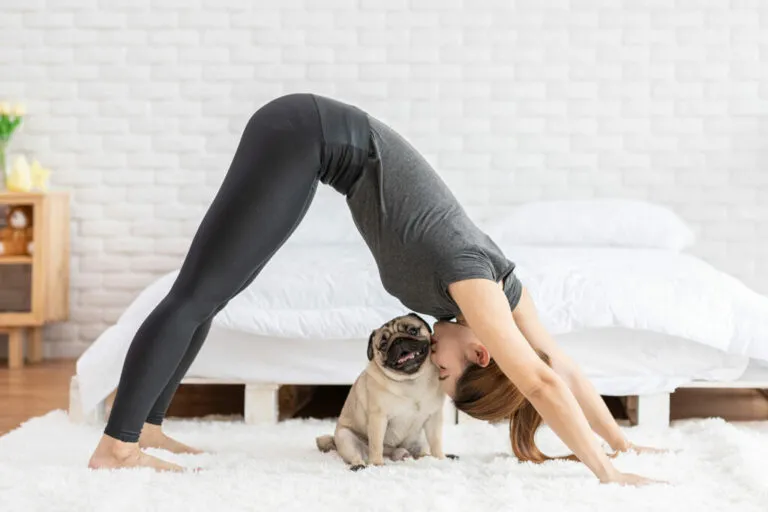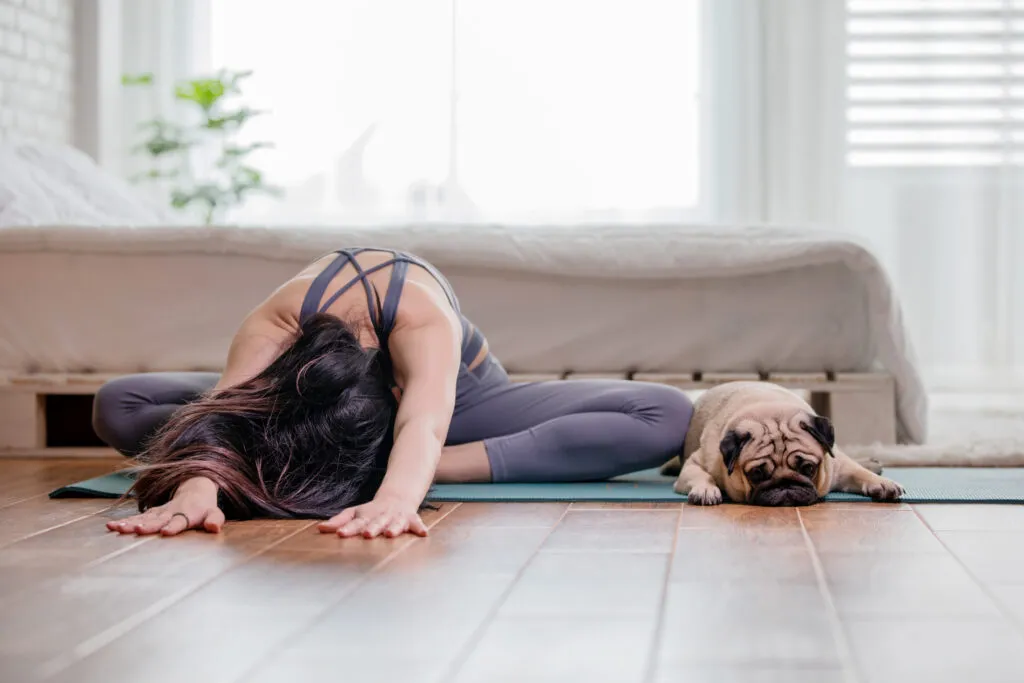Hiking with Dogs – Everyday Adventures
Be it short hikes in the surrounding area, day trips at the weekend or whole hiking holidays with your dog, hiking is a great hobby for human-canine teams!
Many people are currently spending more time than usual at home due to the coronavirus pandemic. Not just gym closures have led many people to look for opportunities to keep fit in the four walls of their home. All the better if their dog benefits too. So how about dog yoga? We'll offer tips for interested yoga fans and those who want to become one.

© omkwan7 / stock.adobe.com
Even new yoga fans know that yoga and animals belong together, because many asanas, i.e. yoga positions, are inspired by animals. There’s even a dog amongst them: the downward dog. Common asanas include the cat, pigeon and crocodile. Calm, concentrated yoga movements do both humans and dogs good. Yoga with dogs is described by the term ‘doga’, which is a combination of ‘dogs’ and ‘yoga’. Suzi Teitelman from the US came across this idea. Around 20 years, the yoga teacher started to integrate dogs in her yoga course and has trained many doga or dog yoga trainers since then. The primary objective isn’t participation in the asanas, because dogs obviously can’t do every exercise in harmony with you. However, just watching or cosily lying alongside their owner whilst they do yoga can have a positive effect on dogs. We’ll give you tips in order to harmonise your dog and yoga.
With some creative thinking, dogs can participate whilst you do some asanas. Some dogs stumble upon the idea of imitating their owner with positions like the downward dog of their own accord: feet stretched forwards, bottom high. When you reward your dog, reinforce its behaviour and encourage it to repeat its dog asana. Be warned though that many owners stop concentrating on the exercises. Some yoga fans consider dogs useful additional weight with holding exercises. Always make sure there is no danger of your dog injuring itself and that it feels secure. Dogs weighing more than 10kg aren’t suitable as extra weight. You of course shouldn’t force your dog into unnatural positions. You’re best off proceeding gently: some dogs can relax particularly well during their owner’s meditation exercises and lie alongside them calmly. Doga teachers believe that the dog’s energy is transmitted to the human and vice versa.
 © jomkwan7 / adobe.stock.com
© jomkwan7 / adobe.stock.com
If you prefer to do yoga without your dog, you shouldn’t just stand firm when assuming the warrior position. This applies in particular to owners of young and curious dogs. If you’re assuming strange positions on the floor at home in your dog’s line of vision for the first time, it’s going to be curious. Perhaps it may even want to help you? Ignore your dog if it places its snout close to your face whilst you’re trying to concentrate on correctly doing the cat position. Your exercises will be less interesting for your dog once you’ve done a few repetitions. You’re best off planning your yoga session after going for a good walk with your dog, so that it will be tired and can calmly watch you doing the pigeon. If your companion is too curious, purchase a chew toy or product for dogs as a helpful distraction.
Dog owners are out and about with their dog several times each day. How about a few occasional yoga exercises? Yoga isn’t just suited to the four walls of your home, but for walks with your dog too. You can do special breathing exercises on the go. You’re best off practising in a tranquil environment. Spectators could disturb you at the beginning in particular, hence many yoga fans are happy to find a solitary spot in the great outdoors. If you take your dog for walks on solitary forest paths, you can practise your usual exercises there. Alternatively, you can find out about special routines like in shirin yoga, also known as the yoga of trees. This primarily focuses on exercises based on solid grounding and the feet, our ‘roots’. Those who do yoga in forests can perform their exercises in harmony with nature without any artificial aids. The dog is mostly a spectator.
You should be able to keep both eyes shut if you wish to do yoga with very young and playful dogs. Dogs interpret your position on all fours as an invitation to play or could begin to nibble at the yoga mat. If interruptions don’t annoy you, you can attempt some relaxation exercises with your four-legged friend. Do them at the end of a long play session. Dogs should be able to perform the basic commands “sit”, “down” and “stay” to be able to do yoga. You won’t be able to relax doing yoga in the woods if you have a dog with a strong hunting instinct. Yoga should always be a good fit for the human-canine team in question. Compulsion and stress are not allowed. Bear this in mind for your own asanas too. If you approach yoga with your dog with a relaxed mindset and don’t present it with impossible tasks, the following benefits are possible:
Elongation is one of the benefits of yoga for humans, but it isn’t advantageous for dogs in any similar way. If you wish to do doga in order to help dogs with joint injuries, you’re best off looking for an alternative animal health practitioner.
Be it short hikes in the surrounding area, day trips at the weekend or whole hiking holidays with your dog, hiking is a great hobby for human-canine teams!
Cheap and yellow – tennis balls are popular dog toys. However, models designed for sports are unsuitable for four-legged friends and pose certain risks. Find out below why the classic tennis balls can be dangerous for dogs and which pet-friendly alternatives are available.
Only for big dogs? No way! Small dogs too can have plenty of fun with agility. Find out here whether your little dog is suited to this dynamic dog sport and which five factors you as a dog owner have to take into account.